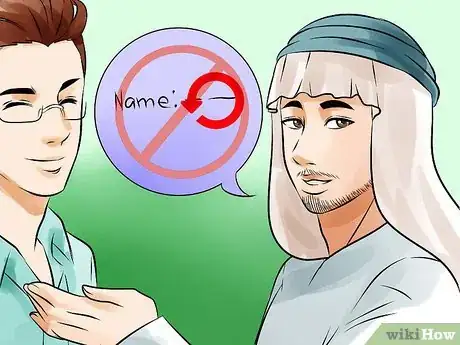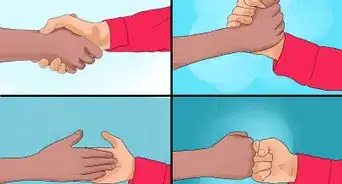This article was co-authored by Patrick Muñoz. Patrick is an internationally recognized Voice & Speech Coach, focusing on public speaking, vocal power, accent and dialects, accent reduction, voiceover, acting and speech therapy. He has worked with clients such as Penelope Cruz, Eva Longoria, and Roselyn Sanchez. He was voted LA's Favorite Voice and Dialect Coach by BACKSTAGE, is the voice and speech coach for Disney and Turner Classic Movies, and is a member of Voice and Speech Trainers Association.
wikiHow marks an article as reader-approved once it receives enough positive feedback. In this case, several readers have written to tell us that this article was helpful to them, earning it our reader-approved status.
This article has been viewed 617,628 times.
Introducing people is both an art and a means of ensuring good manners. A good introduction can get people off to a great conversational start and can help ease any discomfort or unease at meeting for the first time. When you introduce people, the most important, and trickiest, part can be to figure out who should be introduced to whom, based on rank and authority. Once you have that figured out, you can easily help two people get to know each other — and even to start a great conversation in the process. See Step 1 to learn how to introduce people today.
Things You Should Know
- Say the name of the person being introduced to. This should be the person with the "higher rank" among the two people you're introducing.
- Present the other person to the person with the higher rank.
- For example: "Dad, I'd like you to meet my boyfriend, Danny" or "Mr. CEO, I'd like to introduce you to Mr. Employee."
Steps
Introduction Basics
-
1Find an opening. If you want to introduce people to each other, then it's important to get the timing right. You don't want to end up having blundered before the introductions have even begun by introducing the wrong people to each other or by interrupting a fantastic conversation just to get the details out of the way. Here's what you need to know:
- If you find yourself in conversation with two people who don't know each other, try to introduce them as soon as possible. This can get a little tricky. Let's say you're with your college roommate, Amanda, when you run into your friend from high school, Jake, who launches into a story about a mutual friend. Poor Amanda will be standing there feeling awkward and bored while Jake rambles on. It's important to find an opening so that you can include Amanda into the conversation.
- You should avoid introducing someone to people who are in the middle of a serious conversation. Maybe you're at a work event with a client, and you've been eager to introduce him to your boss. While this is an important introduction that should be made, you should avoid doing so if your boss seems to be entangled in a deep conversation with another person. You should wait for an opening, when your boss doesn't seem extremely absorbed; making introductions at the wrong time can lead people to not hit it off as well as they could.
-
2Figure out which person of the two has a higher rank or authority in a social setting. This is important to know because the person of lesser rank or authority should always be presented to the person of higher rank or authority. In general, in a social setting, gender is the "trump card" and determines the higher rank; women are always ranked over men, unless the man is significantly older than the woman. After that, age is the next determining factor; an older person ranks over a younger person, which can be a helpful distinction if both people are of the same gender. Here's what you need to know:[1]
- Your 70-year-old mother-in-law is of greater seniority than your brand new boyfriend.
- Great age takes precedence over most rank or authority, out of courtesy and respect. Your eighty-year-old male neighbor should be ranked higher than your fourteen-year-old niece (according to most people).
- All other things being equal, the person you've known the longest should be named first: introduce your junior friend to your senior friend.
- For social introductions, men are usually introduced to women, as a sign of respect. Gender is not a factor in business settings, where rank is more important.
- Your relatives hold higher rank over your friends.
Advertisement -
3Figure out which person of the two has a higher rank or authority in a business setting. In a business setting, women still have a higher rank over men, and older people still have a higher rank over younger people, but position trumps both age and gender. This means that if a young male is of a higher position than a woman, that the woman should be presented to the man because the man will have the higher rank. Basically, when it comes to a business setting, "position" determines rank first, and after that comes gender, and then age. Here's what you need to know:[2]
- Your boss will be of greater rank or authority than your colleague, partner, or best friend.
- Your senior colleague takes precedence over your junior colleague.
- Your customer or client should be introduced to your employees.
- If you are introducing people of equal rank in the business world, then introduce the person you don't know as well to the person you know better. You should say the name of the person you know better first.
-
4Always state the name of the person with higher rank and present the person of lower rank to them. This can be a bit confusing, but it basically means that you should state the name of the person of higher rank, and then "present" the other person to them. This makes the person of higher rank stand out as the more important person in the situation. Here are some examples:[3]
- Introduce a friend or significant other to a relative. The relative has a higher rank: "Dad, I'd like you to meet my boyfriend, Danny."
- Introduce a lower-ranking business associate to a higher ranking one: "Mr. CEO, I'd like to introduce Mr. Underling."
- Introduce a client to a business associate: "Mr. Client, this is Mr. Money, my associate."
- Introduce a younger person to an older one: "Mr. Oldson, I'd like you to meet Sally Youngling."
- Introduce a man to a woman: "Mary, this is Jeff."
- In a business setting, let rank take precedence over gender. If Mr. Thomas is a higher-ranking male than Mrs. Davis, Mr. Thomas gets the higher authority because of his business position, even though Mrs. Davis is a woman:" Mr. Thomas, may I introduce Mrs. Davis."
-
5Provide background information to help the people start a conversation. You should do this only after you've introduced the people. If they have enough to talk about on their own, that's fine, but if you're trying to facilitate a business conversation or just helping people socialize at a party before moving along, then you can provide a connecting thread that can leave the people to talk on their own, or provide a bit more information about each person and lead them to make the connection. You can help connect the people by mentioning a common interest, a place they both know well, or even a person they both know. Here are some examples of ways to connect people:[4]
- "Elizabeth, have you met Fitzwilliam? I believe you both share a love of reading Jane Austen while walking on the moors."
- "Mom, this is my friend, Stacy. She teaches classes at your yoga studio."
- "Mr. Jones, this is Mr. Smith. Mr. Smith has been helping me on the Connor account. We never would have closed the account if it wasn't for your help, Mr. Jones."
- "Mary, I'd love for you to meet Mark Charles, my neighbor. Mark is actually a published writer. Mary has just started taking creative writing classes."
- "Amy, have you met Rick? Rick actually works with Jeff, your roommate. Isn't Jeff the greatest? I wish he could be here tonight..."
Etiquette
-
1Make a formal introduction correctly. Most formal introductions will relate to the workplace, but they can also take place during formal social events, or if you're with distinguished people. If you're introducing people in a formal setting, then you should use the first and last names of the people, along with the phrases,"May I present", "I'd like to introduce", or "Have you met..." Some people think you should not use the word "introduce," as it can cause confusion or come off as too direct, but it's up to you to decide. Here's what you should do:[5]
- Name the person of greater rank or authority first.
- Use both first and last names, and include any title such as "Dr./Sir". For example, "Dr. Jones, may I introduce Stephanie Smith. Dr. Jones is my art history professor. Stephanie is an art history major."
- Include relevant details as you introduce the two together, such as any established relationship you have with the person you're introducing. For example, you might say: "Mr. Boss, may I present Mark Jones. Mr. Boss is my boss. Mark Jones is my associate."
-
2Make an informal introduction correctly. For a less formal occasion, such as your backyard barbecue, you can simply present both people to one another by name by saying something like, "Fitzwilliam Darcy, Elizabeth Bennet." You can also connect the people more casually and say something like, "I've been dying for you to meet..."In an informal setting, you can worry less about how to phrase everything and more about getting people talking.[6]
- Using first names only is fine in informal situations.
-
3Make a group introduction correctly. In this case, you will need to spend a little time introducing the newcomer to each individual of the group unless it's a small, informal group where a general introduction would suffice and it's neither time-consuming nor disruptive to name each member of the group while you have the group's attention.[7]
- For more formal, larger groups, introduce the newcomer to the whole group first, then take the newcomer to each person and introduce by name: "Caroline, this is Fitzwilliam, my boss; Lydia, this is Fitzwilliam, my boss," etc. Continue working your way around the group in this manner.
- Though you may think it's funny or just easier to say, "Mary, this is everybody. Everybody, this is Mary," this doesn't actually help get a conversation going. Besides, it's rude to "everybody," because it makes it seem like you don't think it's worth it for Mary to get to know each person. Of course, use your discretion: if you're at a loud party and Mary just got there, it may be overwhelming to introduce her to twelve new faces immediately. Instead, ease Mary into the conversation and introduce her to a few people at a time.
-
4Do not repeat names or reverse the introduction. In both formal and informal cases, you do not need to reverse the introductions. It's obvious to both parties who is who. Repeating names or reversing the introduction can make things a bit tedious, and you'll be making a social blunder.
-
5Be delicate when you don't know a person's name. We've all been there. You try to introduce two people when you realize that you just completely forgot the name of the person standing in front of you. There are two approaches you can take:
- Politely excuse yourself and say, "I'm so sorry, would you mind reminding me of your name?"
- Try to be sneaky. Say, "Have the two of you met?" Then pause and wait for the people to introduce themselves. This isn't a perfect maneuver, but it can help you in a pinch, especially if you've forgotten the name of a person you've met several times!
-
6Use common sense when deciding what to call people. The general rule of thumb is that you should introduce people to each other by what you normally call them. For example, if you're great friends with your former professor, Lucy Houston, you can just introduce her to your boyfriend as "Lucy," if that's what you always call each other. If you're in a more formal situation and the person has not given you permission to call him or her by his or her first name, and you have always called the person by "Dr." or "Mr.," then you should keep doing that.
- When in doubt, go with the more formal option. It's better to have your boss say, "You can call me Bob instead of Mr." instead of having your boss bristle when you call him "Bob" instead of "Mr."
Community Q&A
-
QuestionWhy is it important to make introductions between people?
 Community AnswerIntroductions give strangers something to go off of for conversation, like what they have in common or would find interesting about one another.
Community AnswerIntroductions give strangers something to go off of for conversation, like what they have in common or would find interesting about one another. -
QuestionHow do I introduce my cleaning lady if the situation arises?
 Tom De BackerTop AnswererWhen people come to your house while the cleaning lady is working, alert them to this fact as they arrive. "Hi, great to see you, come in, my cleaning lady Anna is working upstairs." Or, if they are immediately in the same space, "Hey, come in, this is my cleaning lady Anna."
Tom De BackerTop AnswererWhen people come to your house while the cleaning lady is working, alert them to this fact as they arrive. "Hi, great to see you, come in, my cleaning lady Anna is working upstairs." Or, if they are immediately in the same space, "Hey, come in, this is my cleaning lady Anna." -
QuestionWho is considered to be a significant other?
 Community AnswerA significant other is any person with whom you are engaged in a romantic relationship; typically it's used in lieu of boyfriend or girlfriend, but even spouses qualify as "significant other."
Community AnswerA significant other is any person with whom you are engaged in a romantic relationship; typically it's used in lieu of boyfriend or girlfriend, but even spouses qualify as "significant other."
Warnings
- If you forget someone's name, don't fudge it. Simply admit that the person's name has "escaped your memory" for the moment; be humble!⧼thumbs_response⧽
- It is important to note that there are cultural, societal and regional variations when it comes to introducing people. For example, the advice in this article has been based on the American expectations, whereas the video has a British approach. While very similar, there are nuances that you might wish to find out about if you are in unfamiliar territory. In a similar vein, there will be differences between business and social introductions, where some conventions that apply to one situation do not apply to the other.⧼thumbs_response⧽
- Subjects to avoid raising in an introduction include divorce, bereavement, job loss, illness, etc.[9] Topics like these leave everyone feeling uncomfortable and unsure of what to say next.⧼thumbs_response⧽
Things You'll Need
- Knowledge of the rank or authority
- Knowledge of possible common ground between the parties
Expert Interview
Thanks for reading our article! If you'd like to learn more about introducing people, check out our in-depth interview with Patrick Muñoz.
References
- ↑ https://www.indeed.com/career-advice/interviewing/how-to-do-introductions
- ↑ https://www.indeed.com/career-advice/interviewing/how-to-do-introductions
- ↑ https://www.indeed.com/career-advice/interviewing/how-to-do-introductions
- ↑ https://www.indeed.com/career-advice/interviewing/how-to-do-introductions
- ↑ https://www.rpi.edu/dept/advising/esl/american_culture/social_skills/intros.htm
- ↑ https://www.artofmanliness.com/character/etiquette/how-to-make-introductions-like-a-gentleman/
- ↑ https://www.artofmanliness.com/character/etiquette/how-to-make-introductions-like-a-gentleman/
- ↑ Peggy Post, Excuse me, but I was next, p. 36, (2006), ISBN 978-0-06-088916-6
- ↑ Peggy Post, Excuse me, but I was next, p. 36, (2006), ISBN 978-0-06-088916-6
About This Article
To introduce people, determine which person has higher social rank or more authority and state that person's name first. For example, if you're introducing a significant other to a relative, you can say, "Dad, I'd like you to meet my boyfriend, Robert." In general, introduce people to each other by using the name you usually call them. For instance, if you're close to your former professor, Allison Knight, you can introduce her to your boyfriend as "Allison," if that's what you always call her. For tips on making formal introductions in a work setting, read on!










































































